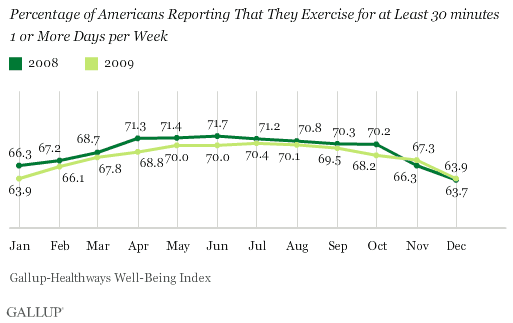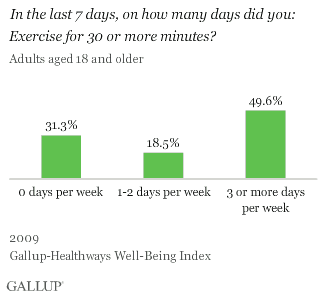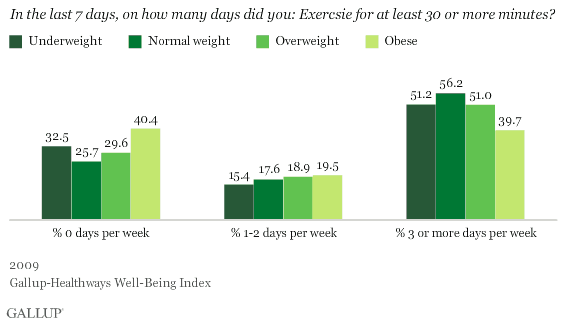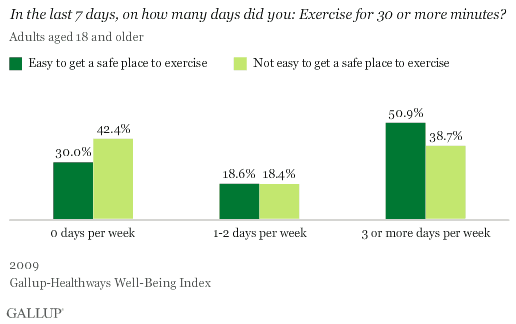WASHINGTON, D.C. -- With New Year's resolutions aimed at slimming down and getting in shape top of mind for many Americans, Gallup-Healthways Well-Being Index data reveal that Americans have some ground to make up in 2010 in terms of exercise frequency. The percentage of Americans saying they exercised for at least 30 minutes 1 day or more per week decreased from an average of 69.1% in 2008 to 68.1% in 2009, with year-over-year comparisons down for 10 out of 12 months last year.

Gallup and Healthways ask at least 1,000 Americans each day about their exercise frequency. Specifically, respondents are asked to report on how many days in the last 7 they exercised for at least 30 minutes. Monthly aggregates typically consist of 28,000 to 30,000 interviews.
While many Americans may be recommitting to a more physically fit lifestyle at the start of the new year, Gallup data from 2008 and 2009 show that January is actually one of the months when Americans exercise the least. Exercise follows a typical seasonal pattern, with frequency picking up in the spring and summer and declining in the fall and winter.
Parsing out the 2009 data shows that nearly half (49.6%) of Americans reported that they exercised for at least 30 minutes 3 or more days per week. Another 18.5% said they exercised 1 or 2 days per week for at least 30 minutes, and 31.3% reported they did not exercise on any day in a given week.

Frequent Exercise More Common Among Certain Demographics
Looking specifically at frequent exercisers -- defined as those getting at least 30 minutes 3 or more days per week -- reveals that Americans making $90,000 or more per year (54.3%), those aged 18-29 (53.8%), and people living in the West (53.5%) are among those most likely to report this level of physical activity. Americans making less than $36,000 annually (46.6%), Midwesterners (47.9%), women (48.1%), and those 65 years old and older (48.3%) are somewhat less likely to report frequent exercise.

Many Obese Americans Struggle to Exercise at All
At 40.4%, Americans who are obese are far more likely than those in any other weight classification to report that they do not exercise for at least 30 minutes on any day in a given week. Normal weight Americans are more likely than those in any other weight group to report frequent exercise, with an average of 56.2% saying they exercised for at least 30 minutes 3 or more days per week in 2009.

These findings add to Gallup's previous reporting underscoring the importance of promoting regular exercise among obese adults that showed that even for the obese, engaging in some level of exercise decreases one's likelihood of having been diagnosed with diabetes. Gallup determines weight categories based on respondents' self-reports of their height and weight, which are then used to calculate standard Body Mass Index scores. Individual BMI values of 30 or above are classified as "obese."
A Place to Workout
In addition to asking about exercise frequency, Gallup and Healthways also survey Americans about whether it is easy to get a safe place to exercise in the city or area where they live. Those who do not have a safe place to exercise are far more likely than those who do to report that they did not exercise at all in a given week -- 42.4% vs. 30.0%. And likewise, those with a safe place to exercise are much more likely than those without such a place to say they exercise for at least 30 minutes, 3 or more days per week.

The finding that those without a safe place to exercise are far more likely to report not exercising at all may point to one underlying factor contributing to the relationship between income and frequency of exercise. Lower income Americans, a group less likely to report frequent exercise, may tend to live in neighborhoods where there aren't safe places to exercise. And lack of income would clearly be an obstacle to affording a gym membership.
Bottom Line
While the benefits of frequent exercise have long been proven and are widely understood among the public, many Americans have yet to commit to a physically active lifestyle, with a consistent one-third of the adult population reporting that they are not exercising at all in a given week. Gallup and Healthways have been measuring exercise frequency in the United States since the start of 2008 and find that Americans reported exercising less often in 2009 than in 2008.
Higher income Americans, 18- to 29-year-olds, those living in the West, and men all report exercising for at least 30 minutes 3 or more days per week at levels higher than the 2009 national average (49.6%). At the other end of the spectrum are the obese and lower income Americans, with the percentage of these groups reporting exercising at least three days per week falling significantly below the 2009 national average -- 9.9 points below and 3 points below, respectively. Additionally, Americans who say they lack a safe place to exercise are far more likely to avoid exercise completely than those who report they do have somewhere safe to workout.
Learn more about the Gallup-Healthways Well-Being Index.
Survey Methods
For the Gallup-Healthways Well-Being Index, Gallup is interviewing no fewer than 1,000 U.S. adults nationwide each day. All monthly samples are near 30,000 per month. For monthly results based on the total sample of national adults, one can say with 95% confidence that the maximum margin of sampling error is ±0.6 percentage point.
Over 350,000 surveys were completed in each calendar year, yielding percentages with maximum expected error range of ±0.2%.
Interviews are conducted with respondents on landline telephones and cellular phones.
In addition to sampling error, question wording and practical difficulties in conducting surveys can introduce error or bias into the findings of public opinion polls.
About the Gallup-Healthways Well-Being Index™
The Gallup-Healthways Well-Being Index measures the daily pulse of U.S. wellbeing and provides best-in-class solutions for a healthier world. To learn more, please visit well-beingindex.com.
